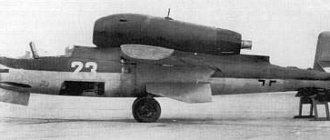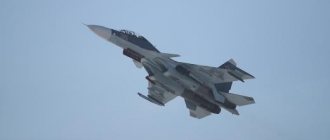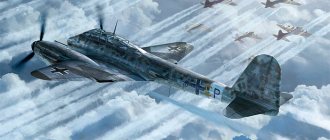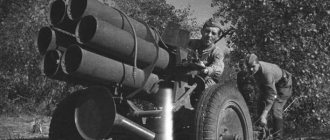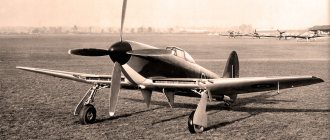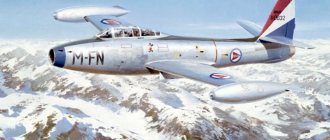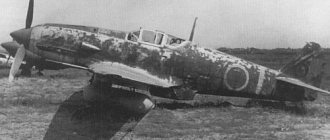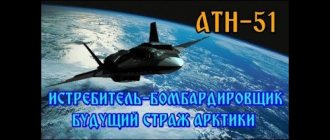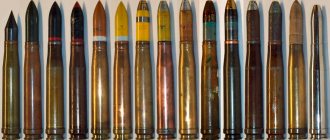Before the start of the Great Patriotic War, the design bureau of Artem Mikoyan and Mikhail Gurevich was formed. The first project of this bureau was the MiG-1 high-altitude fighter (later became the MiG-3). The fighter was used only in the initial period of the war, and the remaining developments of the design bureau remained either experimental or were produced in small series. Their fighters were not popular.
But the situation changed dramatically when, after the war, the new serial jet fighter of the USSR MiG-9 was released.
History of the MiG-9
After the end of World War II, the Soviet Union began to intensify its work towards the creation of jet aircraft. Four design bureaus at once (Yakovlev, Sukhoi, Mikoyan and Lavochkin) were entrusted with the task of developing jet fighters. Due to the fact that the Soviet industry had not yet produced its own jet engine, the captured German BMW-003A and Junkers YuMO-004 became the basis for the creation of the first jet aircraft. At that time, Germany, England and the USA already had serial production of jet technology and were actively exploiting it.
For this reason, Soviet designers were given the task not only to build a jet fighter, but to do it as quickly as possible in order to reduce the development gap from world leaders in this field.
The Mikoyan Design Bureau proposed two projects at once, equipped with BMW-003A engines. In the first project (I-260), the engines were mounted under the wings, the layout was similar to the Me-262. The second project, called I-300, had a modified layout, and the power plant was located in the fuselage.
During the research, it was decided to leave the second I-300 project, and abandoned the I-260. It was the I-300 that in serial production acquired the name MiG-9 and was put into service. An interesting fact is that this aircraft was flown just a few hours before the second Yak-15 jet, thus becoming the first Soviet jet fighter to take to the skies.
The MiG-9, together with the Yak-15 and Yak-17, became the transitional fighters from the piston-powered models of World War II to the transonic jet MiG-15.
The history of the creation of the first jet aircraft of the USSR
Already at the end of World War II, it became clear that the future of aviation belonged to jet aircraft. In the Soviet Union, work began in this direction; it went much faster after becoming familiar with captured German developments. At the end of the war, the USSR was able to acquire not only intact German aircraft and jet engines, but also seize the German factories where they were produced.
The task to create a jet fighter was simultaneously received by four leading aviation design bureaus of the country: Mikoyan, Lavochkin, Yakovlev and Sukhoi. The main problem was that at that time the USSR did not have its own jet aircraft engine; it had yet to be created.
Meanwhile, time was running out: potential opponents - the USA, England and Germany - already had established serial production of jet aircraft and were actively exploiting this technology.
The first Soviet jet fighters used captured German BMW-003A and YuMO-004 engines.
The Mikoyan Design Bureau worked on the creation of two fighters, which at the project stage were designated I-260 and I-300. It was planned to use the BMW-003A engine on both cars. Work on the aircraft began in February 1945.
The I-260 copied the German Me.262 fighter; two jet engines were located under the wings of the aircraft. The I-300 had a layout with a power plant inside the fuselage.
Purges in the wind tunnel showed that the layout with engines inside the fuselage is more advantageous. Therefore, it was decided to abandon further work on the I-260 prototype and complete the I-300, which later became the first production Soviet jet fighter under the designation MiG-9.
Three experimental vehicles were built for testing: F-1, F-2 and F-3. The F-1 aircraft was ready by December 1945, but the development of the aircraft took until March of the following year, and only then did testing begin. On April 24, 1946, the fighter took off for the first time; the first flight went well.
Already the initial stage of testing clearly showed the enormous superiority of jet aircraft over piston aircraft: the MiG-9 was able to accelerate to a speed of 920 km/h, reach a ceiling of 13 km and gain an altitude of 5 thousand meters in 4.5 minutes. It should be said that initially they planned to arm the aircraft with a 57-mm N-57 automatic cannon, installing it in the partition between the air intakes and two 37-mm NS-23 cannons located in the lower part of the fuselage. However, later they decided to abandon the 57-mm cannon, considering its power excessive.
On July 11, 1946, a tragedy occurred: during the flight, a fragment that came off the wing damaged the stabilizer, causing the aircraft to lose control and crash into the ground. The pilot died.
The second experimental F-2 aircraft was demonstrated to the public during the air parade in Tushino. In August, the Kuibyshev plant began production of a small production batch of ten aircraft. It was planned that they would take part in the parade on Red Square in October 1946.
In March 1947, serial production of the fighter began. However, after the production of 49 aircraft it was suspended. The car had to be urgently rebuilt. Within two months, the fuel system on the MiG-9 was seriously modernized, the design of the tail fairing was changed, the keel area was increased, and a number of other improvements were also made. After this, mass production was resumed.
In June 1947, state tests of four fighters, two prototypes (F-2 and F-3) and two production aircraft, were completed. In general, the MiG-9 received positive reviews: in terms of speed characteristics, rate of climb and flight altitude, it was significantly superior to all piston aircraft in service with the Soviet army. The firepower of the vehicle was also unprecedented.
There were also problems: when firing cannons at an altitude of more than 7 thousand meters, the engine stalled. They tried to fight this shortcoming, but they could not completely eliminate it.
If we compare the characteristics of the MiG-9 with the Yak-15 jet fighter, which was developed at the same time, then the Mikoyan aircraft was inferior to the Yakovlev Design Bureau aircraft in maneuverability, but was faster in horizontal flight and during a dive.
The new car was greeted by the troops without much enthusiasm. Pilots were often simply afraid to fly an airplane that did not have a propeller. In addition to the pilots, the technical staff also had to be retrained, and this had to be done as quickly as possible. Haste often led to accidents that had nothing to do with the technical features of the aircraft.
Design features of the aircraft
Mikoyan's fighter was created with an eye to the traditional design, which underlay all piston fighters existing at that time. There was nothing new in the design of the aircraft, except for the engine compartment and the lower part of the fuselage. The aerodynamic shape and configuration of the fuselage exactly repeated the shape of Soviet piston fighters. The tail unit, which cantilevered the stabilizer, had a high location.
The aircraft layout is semi-monocoque, with a mid-wing arrangement. In the forward part of the fuselage there were two tunnels that served as air intakes. The air ducts had an elliptical cross-section and ran under the skin on the sides of the machine body. The pilot's cockpit was located in the middle part of the aircraft and was equipped with an oblong streamlined canopy.
The fighter had a landing gear with three legs. Unlike piston engines equipped with a tail steering wheel, the new fighter had a nose support strut. For effective use in unpaved airfield conditions, the landing gear had oscillating forks and were equipped with remote shock absorbers. The chassis retracts automatically using a pneumatic drive.
The engine compartment of the car was located at the bottom of the fuselage. Two RD-20 engines are located next to each other, based on the given design. The engines were started using a starting device. The main fuel of the first jet fighter was aviation gasoline. Fuel tanks were located in the middle part of the fuselage and in the wings. The total capacity of the fuel tanks is 1600 liters.
The pilot had at his disposal a radio compass, an RSI-6 radio station and a KP-14 oxygen supply complex. Power supply to all aircraft systems was carried out using a captured generator. On later production vehicles, captured parts were replaced with domestic devices.
Characteristics of the MiG-9
Below are the characteristics of the MiG-9.
| Wingspan, m | 10 |
| Length, m | 9.75 |
| Height, m | 3.225 |
| Wing area, sq. m | 18.20 |
| Max. take-off weight, kg | 4998 |
| Engine | 2 RD RD-20 |
| Thrust, kgf | 2 x 800 |
| Max. speed, km,/h | 910 |
| Practical range, km | 800 |
| Rate of climb, m/s | 806 |
| Practical ceiling, m | 12800 |
| Armament | 37 mm N-37 cannon, 2 x 23 mm NS-23 cannons |
Subsequent fate of the car
In October 1946, State tests of the vehicle began, which were carried out in close cooperation with the design bureau of A. Yakovlev. Created at the Yakovlev Design Bureau, the Yak-15 was the main competitor of the “ninth” MiG. Based on the results of test flights, the State Commission reviewed the demonstrated flight performance characteristics of the brainchild of the Mikoyan Design Bureau, which were as follows:
- the maximum speed of the car at an altitude of 5000 m reached 910 km/h;
- the time to climb to 5000 m is 4.3 minutes;
- the aircraft's service ceiling was 13,500 m;
- average flight duration is 1 hour 27 minutes;
- flight range at different altitudes was 700-800 km;
- landing speed of the machine is 225-300 km.
In some aspects, the MiG-9 fighter showed excellent characteristics, but due to its greater flight weight, in terms of maneuverability and some flight parameters of the Mikoyan aircraft, it was inferior to the Yakovlev Design Bureau product.
Even at the stage of factory testing, by Order of the Ministry of Aviation Industry, Aviation Plant No. 1 was instructed to start producing a pilot series of the fighter. This was done not only due to the need to have ready-made vehicles for full testing, but also for political purposes. The November air parade, timed to coincide with the anniversary of the October Revolution, was supposed to take place with the participation of Soviet jet technology.
In parallel with the work on the pilot series, the plant was preparing the technological base for the production of a new machine in a large series. At the end of 1946, the plant received new technical documentation, new equipment and the necessary equipment. In March 1947, the plant produced the first production batch of 48 fighters. For an aircraft that was created in such a hurry and was tested at an accelerated rate, it was typical to have numerous defects. In the first production batch alone, experts identified 37 design and technical defects.
The MiG-9 production aircraft of the Soviet Air Force was equipped with Soviet RD-20 turbojet engines, which were copied from the captured BMW-003 jet engine. The new Soviet engines had a number of serious defects and too short a working life. Only in subsequent batches did the RD-20A1 and RD-20A2 engines begin to be installed, the service life of which was increased to 25 and 50 hours, respectively.
Armament
In 1941, the MiG-3 fighter was armed with one heavy machine gun and two rifle calibers. The MiG-9 could only “laugh” at such firepower.
Initially, it was planned to install a 57 mm caliber cannon on it (installed on the first few copies).
But in the end, the plane was armed with a battery of 3 guns. Two 23 mm NS-23 cannons were mounted in the forward part of the fuselage, under the air intake. Behind the partition dividing the air intake into 2 channels, a 37 mm N-37 gun was installed. The cartridge boxes were located in front of the cabin, between the armored bulkheads. Both 23 mm guns had 80 rounds of ammunition, 37 mm 40 rounds.
The first aircraft had a simple PKI-1 collimator sight. Later they began to install the ASP-1N sight, equipped with a gyroscope system that generates corrections for lead (with a known range to the target). The results of the shooting were recorded by a film camera gun. A similar set of weapons will remain on subsequent KB fighters, including the MiG-17. But the installation of missile or bomb weapons on the fighter was not intended.
Exploitation
The first MiG-9s, produced in a large series, left the assembly shops in the spring of 1947. It was assumed that they would be able to take part in the May Day parade, but due to the hasty launch of the fighter into series and the unfinished design, production had to be temporarily stopped. However, MiG-9s appeared at the parade.
New fighters began to arrive in combat units simultaneously with the Yak-15.
At the same time, Yakovlev’s aircraft, which retained not only its external resemblance to the Yak-3, but also similar to it in piloting technique, was at first easier and more readily mastered. But the distrust of the more “promising”, but even unusual in appearance, MiG-9 was higher. In addition, the development of technology was hampered not only by the lack of experience in working with jet aircraft; they simply did not fit into the allotted time frame. In fact, the “turning point” in attitude towards the new fighter occurred only in 1948.
The constant rush led to the fact that during operation new shortcomings were constantly being identified, and the plant was constantly trying to eliminate them. For example, when firing cannons at high altitudes, the engines stalled. To combat this, localizers called “silencers” began to be mounted on gun barrels. It turned out that the “silencer” of the N-37 gun soon failed and simply fell apart. It ended with the Minister of State Control L. Mehlis reporting to the government about the poor quality of the MiG-9.
They reasonably objected to him: the aircraft was designed at an emergency pace and was hastily launched into production, without even waiting for state tests. And measures to eliminate shortcomings are being taken. After the MiG-15 was put into service, production of the “ninth” was stopped. Most of the aircraft were transferred to China, where the MiG-9 was used for retraining pilots.
Jet era
The end of the Second World War was marked by the appearance in the sky of new models of military equipment, with which the Third Reich pinned hopes of concluding peace on favorable terms. The appearance of the Henkel 162 and Messerschmitt 262 jet fighters in the Luftwaffe threatened to complicate the situation on the fronts for the Allies in tactical terms. However, in this situation, time was already playing against Nazi Germany and new, advanced military equipment could not save the country from disaster.
One should not think that the Germans were the only ones who managed to achieve real success in this field. Similar work was carried out in England and the USA. Despite the difficult economic situation of the Soviet Union, design bureaus were actively working on the creation of jet aircraft. Work in this direction took on a special scope after Soviet pilots first encountered German jet fighters in the sky in February 1945. A review of the results of a combat collision with the latest German jet fighters allowed Soviet pilots to develop new air combat tactics.
The first acquaintance with a fast enemy aircraft took place in February 1945 in the area of the German city of Frankfurt on the Oder. The meeting with Soviet fighters ended in vain for both sides, but it immediately became clear to the Soviet pilots what advantages jet technology had. For pilots of Soviet fighter and attack units, encounters with the latest German fighters were random, while for the Allied bomber aviation, the Me 262 jets became a real threat.
In the Soviet Union, all leading design bureaus were involved in the creation of a jet fighter. The teams of Mikoyan and Yakovlev were engaged in the design of the new machine officially, but Lavochkin and Sukhoi carried out their work on their own initiative. Soviet aircraft designers quickly managed to create the aircraft's airframe. By the summer of 1945, the Mikoyan and Yakovlev design bureaus began aerodynamic tests. The only thing that held back Soviet aircraft designers from completing the work was the lack of domestic jet engines. There were experimental developments of jet engines, but they were crude products, not distinguished by either sufficient jet thrust or a high degree of reliability.
Modifications
After the MiG-9 was put into service, they were going to produce a training “spark” at its base. Testing of the two-seater aircraft was completed in 1948, but by this time the new MiG-15 fighter was already being prepared for production. As a result, the “Sparka” was used as a flying laboratory for testing the designs of ejection seats.
On the plane with the code "FP" they tried to combat the engine stopping during firing by moving the 37 mm cannon.
This did not solve the problems. They wanted to equip the MiG-9 with the code “FF” with uprated RD-20F engines. Since development of the MiG-15 was nearing completion, the change was considered inappropriate.
The MiG-9M was equipped with uprated engines, a pressurized cabin with an ejection seat, and the placement of the guns was completely changed. But even in this form the fighter was worse than the promising MiG-15.
